HR Professional Map: My Role, Strengths, and Development
VerifiedAdded on 2022/08/11
|8
|1199
|30
Report
AI Summary
This report analyzes the CIPD's HR Professional Map, a framework for HR professionals, detailing its structure of professional areas, behaviors, and competence bands. The report explores the author's current role in talent and resourcing management, aligning their activities with the map's levels. It highlights strengths in personnel development and identifies areas for growth, particularly in insights, strategy, and solutions, and leading HR. The author references the map to understand their current band levels and suggests how to improve in areas like training and development, and other HR skills. The report includes a bibliography of relevant sources to support the analysis of the HR Professional Map.
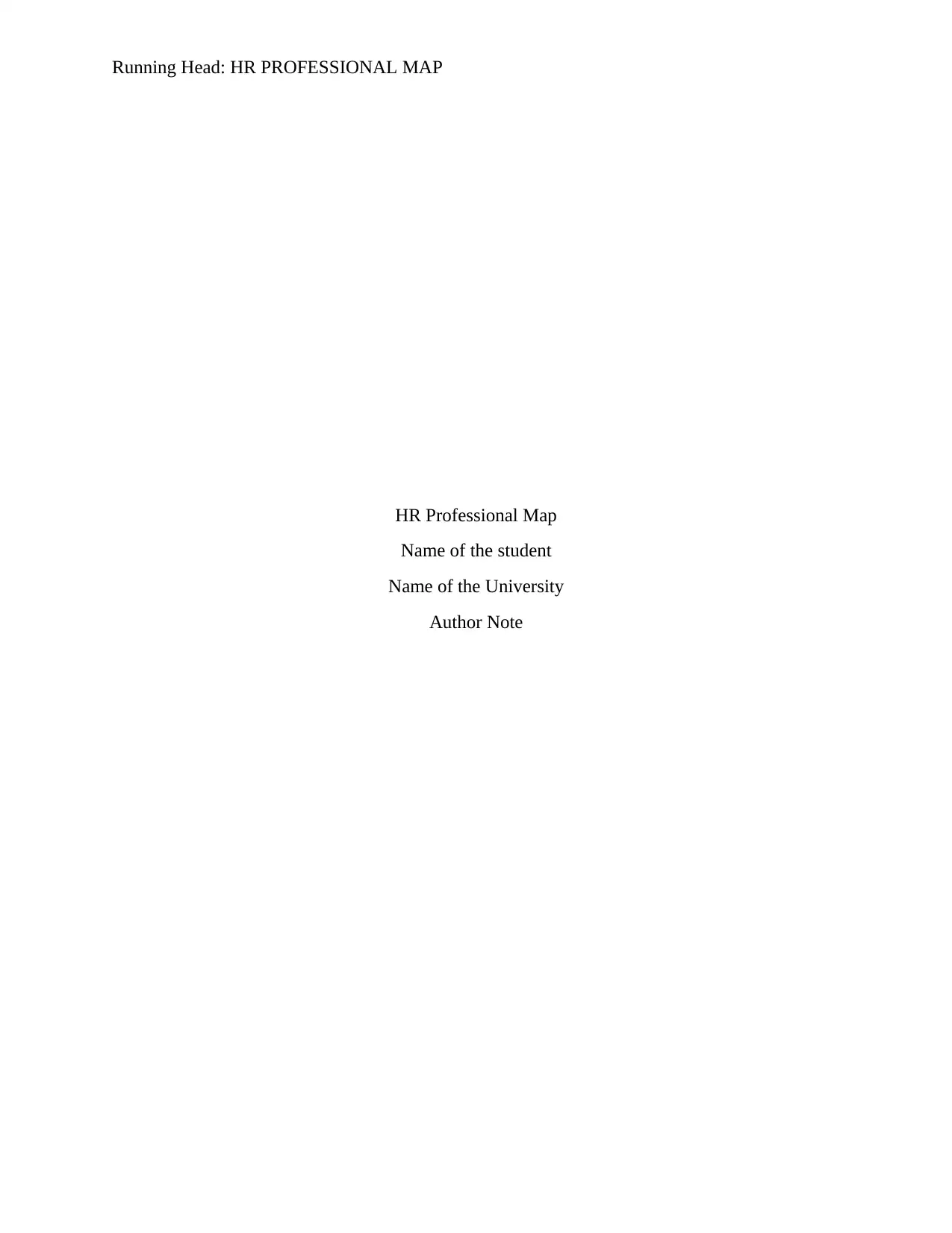
Running Head: HR PROFESSIONAL MAP
HR Professional Map
Name of the student
Name of the University
Author Note
HR Professional Map
Name of the student
Name of the University
Author Note
Paraphrase This Document
Need a fresh take? Get an instant paraphrase of this document with our AI Paraphraser
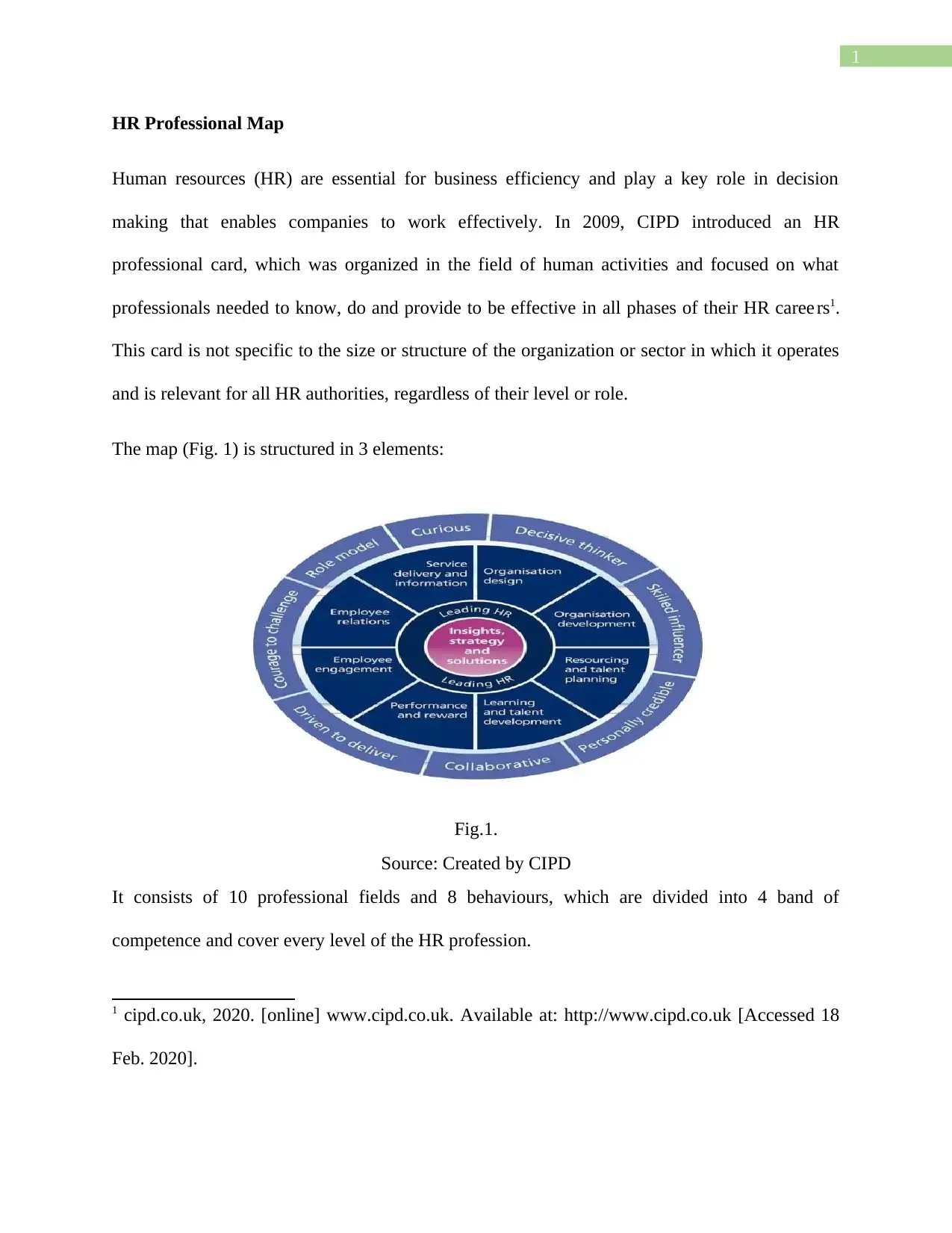
1
HR Professional Map
Human resources (HR) are essential for business efficiency and play a key role in decision
making that enables companies to work effectively. In 2009, CIPD introduced an HR
professional card, which was organized in the field of human activities and focused on what
professionals needed to know, do and provide to be effective in all phases of their HR caree rs1.
This card is not specific to the size or structure of the organization or sector in which it operates
and is relevant for all HR authorities, regardless of their level or role.
The map (Fig. 1) is structured in 3 elements:
Fig.1.
Source: Created by CIPD
It consists of 10 professional fields and 8 behaviours, which are divided into 4 band of
competence and cover every level of the HR profession.
1 cipd.co.uk, 2020. [online] www.cipd.co.uk. Available at: http://www.cipd.co.uk [Accessed 18
Feb. 2020].
HR Professional Map
Human resources (HR) are essential for business efficiency and play a key role in decision
making that enables companies to work effectively. In 2009, CIPD introduced an HR
professional card, which was organized in the field of human activities and focused on what
professionals needed to know, do and provide to be effective in all phases of their HR caree rs1.
This card is not specific to the size or structure of the organization or sector in which it operates
and is relevant for all HR authorities, regardless of their level or role.
The map (Fig. 1) is structured in 3 elements:
Fig.1.
Source: Created by CIPD
It consists of 10 professional fields and 8 behaviours, which are divided into 4 band of
competence and cover every level of the HR profession.
1 cipd.co.uk, 2020. [online] www.cipd.co.uk. Available at: http://www.cipd.co.uk [Accessed 18
Feb. 2020].
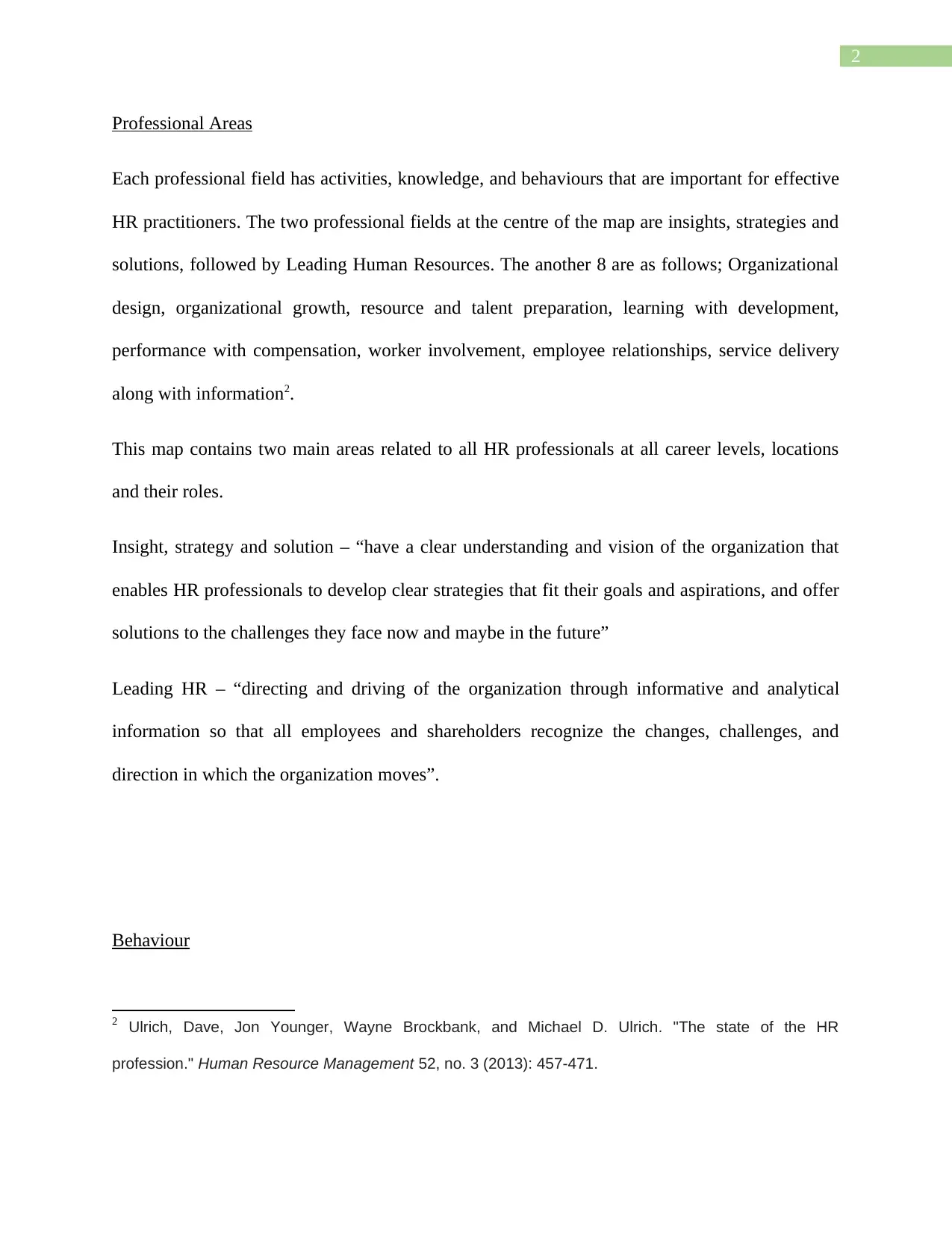
2
Professional Areas
Each professional field has activities, knowledge, and behaviours that are important for effective
HR practitioners. The two professional fields at the centre of the map are insights, strategies and
solutions, followed by Leading Human Resources. The another 8 are as follows; Organizational
design, organizational growth, resource and talent preparation, learning with development,
performance with compensation, worker involvement, employee relationships, service delivery
along with information2.
This map contains two main areas related to all HR professionals at all career levels, locations
and their roles.
Insight, strategy and solution – “have a clear understanding and vision of the organization that
enables HR professionals to develop clear strategies that fit their goals and aspirations, and offer
solutions to the challenges they face now and maybe in the future”
Leading HR – “directing and driving of the organization through informative and analytical
information so that all employees and shareholders recognize the changes, challenges, and
direction in which the organization moves”.
Behaviour
2 Ulrich, Dave, Jon Younger, Wayne Brockbank, and Michael D. Ulrich. "The state of the HR
profession." Human Resource Management 52, no. 3 (2013): 457-471.
Professional Areas
Each professional field has activities, knowledge, and behaviours that are important for effective
HR practitioners. The two professional fields at the centre of the map are insights, strategies and
solutions, followed by Leading Human Resources. The another 8 are as follows; Organizational
design, organizational growth, resource and talent preparation, learning with development,
performance with compensation, worker involvement, employee relationships, service delivery
along with information2.
This map contains two main areas related to all HR professionals at all career levels, locations
and their roles.
Insight, strategy and solution – “have a clear understanding and vision of the organization that
enables HR professionals to develop clear strategies that fit their goals and aspirations, and offer
solutions to the challenges they face now and maybe in the future”
Leading HR – “directing and driving of the organization through informative and analytical
information so that all employees and shareholders recognize the changes, challenges, and
direction in which the organization moves”.
Behaviour
2 Ulrich, Dave, Jon Younger, Wayne Brockbank, and Michael D. Ulrich. "The state of the HR
profession." Human Resource Management 52, no. 3 (2013): 457-471.
⊘ This is a preview!⊘
Do you want full access?
Subscribe today to unlock all pages.

Trusted by 1+ million students worldwide
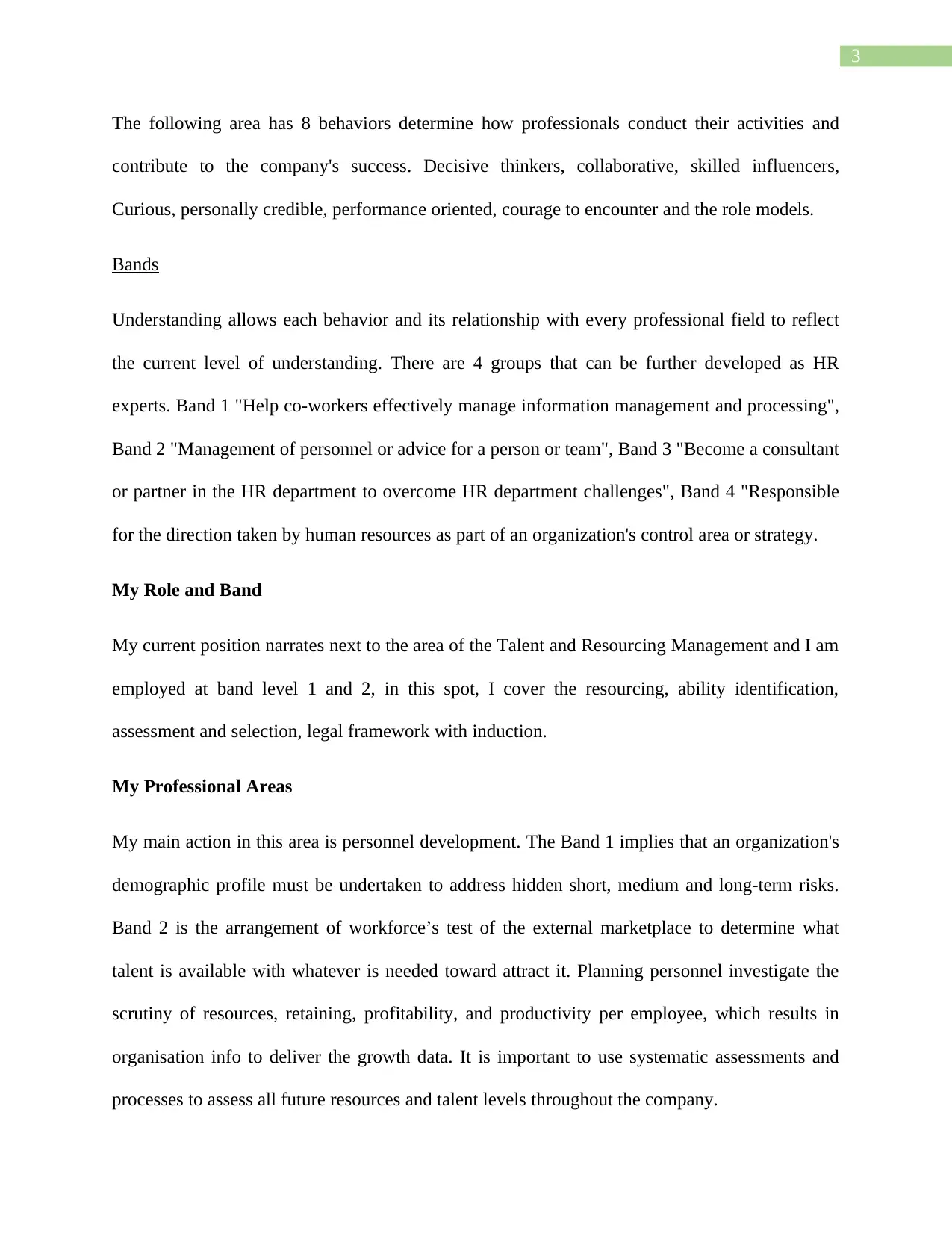
3
The following area has 8 behaviors determine how professionals conduct their activities and
contribute to the company's success. Decisive thinkers, collaborative, skilled influencers,
Curious, personally credible, performance oriented, courage to encounter and the role models.
Bands
Understanding allows each behavior and its relationship with every professional field to reflect
the current level of understanding. There are 4 groups that can be further developed as HR
experts. Band 1 "Help co-workers effectively manage information management and processing",
Band 2 "Management of personnel or advice for a person or team", Band 3 "Become a consultant
or partner in the HR department to overcome HR department challenges", Band 4 "Responsible
for the direction taken by human resources as part of an organization's control area or strategy.
My Role and Band
My current position narrates next to the area of the Talent and Resourcing Management and I am
employed at band level 1 and 2, in this spot, I cover the resourcing, ability identification,
assessment and selection, legal framework with induction.
My Professional Areas
My main action in this area is personnel development. The Band 1 implies that an organization's
demographic profile must be undertaken to address hidden short, medium and long-term risks.
Band 2 is the arrangement of workforce’s test of the external marketplace to determine what
talent is available with whatever is needed toward attract it. Planning personnel investigate the
scrutiny of resources, retaining, profitability, and productivity per employee, which results in
organisation info to deliver the growth data. It is important to use systematic assessments and
processes to assess all future resources and talent levels throughout the company.
The following area has 8 behaviors determine how professionals conduct their activities and
contribute to the company's success. Decisive thinkers, collaborative, skilled influencers,
Curious, personally credible, performance oriented, courage to encounter and the role models.
Bands
Understanding allows each behavior and its relationship with every professional field to reflect
the current level of understanding. There are 4 groups that can be further developed as HR
experts. Band 1 "Help co-workers effectively manage information management and processing",
Band 2 "Management of personnel or advice for a person or team", Band 3 "Become a consultant
or partner in the HR department to overcome HR department challenges", Band 4 "Responsible
for the direction taken by human resources as part of an organization's control area or strategy.
My Role and Band
My current position narrates next to the area of the Talent and Resourcing Management and I am
employed at band level 1 and 2, in this spot, I cover the resourcing, ability identification,
assessment and selection, legal framework with induction.
My Professional Areas
My main action in this area is personnel development. The Band 1 implies that an organization's
demographic profile must be undertaken to address hidden short, medium and long-term risks.
Band 2 is the arrangement of workforce’s test of the external marketplace to determine what
talent is available with whatever is needed toward attract it. Planning personnel investigate the
scrutiny of resources, retaining, profitability, and productivity per employee, which results in
organisation info to deliver the growth data. It is important to use systematic assessments and
processes to assess all future resources and talent levels throughout the company.
Paraphrase This Document
Need a fresh take? Get an instant paraphrase of this document with our AI Paraphraser
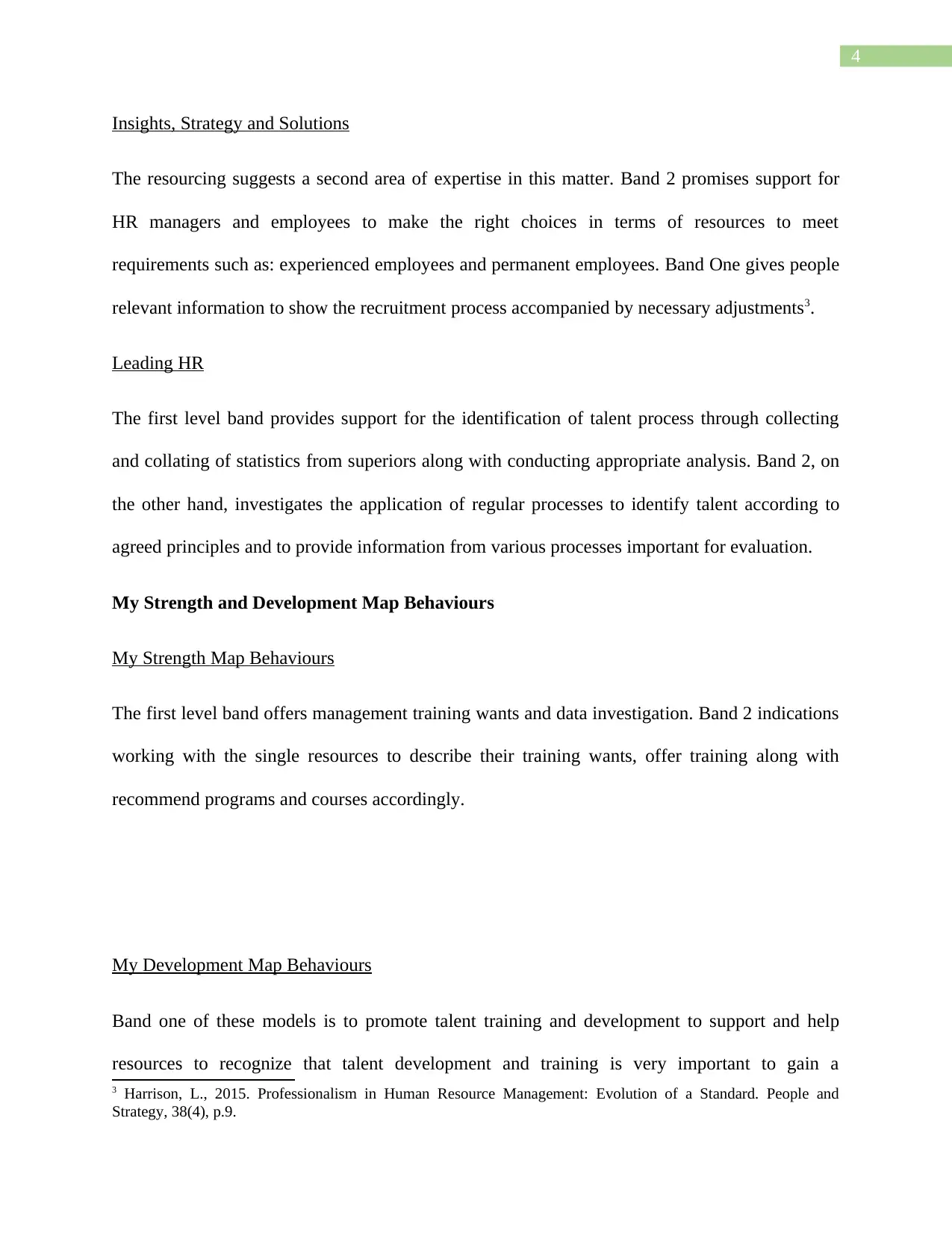
4
Insights, Strategy and Solutions
The resourcing suggests a second area of expertise in this matter. Band 2 promises support for
HR managers and employees to make the right choices in terms of resources to meet
requirements such as: experienced employees and permanent employees. Band One gives people
relevant information to show the recruitment process accompanied by necessary adjustments3.
Leading HR
The first level band provides support for the identification of talent process through collecting
and collating of statistics from superiors along with conducting appropriate analysis. Band 2, on
the other hand, investigates the application of regular processes to identify talent according to
agreed principles and to provide information from various processes important for evaluation.
My Strength and Development Map Behaviours
My Strength Map Behaviours
The first level band offers management training wants and data investigation. Band 2 indications
working with the single resources to describe their training wants, offer training along with
recommend programs and courses accordingly.
My Development Map Behaviours
Band one of these models is to promote talent training and development to support and help
resources to recognize that talent development and training is very important to gain a
3 Harrison, L., 2015. Professionalism in Human Resource Management: Evolution of a Standard. People and
Strategy, 38(4), p.9.
Insights, Strategy and Solutions
The resourcing suggests a second area of expertise in this matter. Band 2 promises support for
HR managers and employees to make the right choices in terms of resources to meet
requirements such as: experienced employees and permanent employees. Band One gives people
relevant information to show the recruitment process accompanied by necessary adjustments3.
Leading HR
The first level band provides support for the identification of talent process through collecting
and collating of statistics from superiors along with conducting appropriate analysis. Band 2, on
the other hand, investigates the application of regular processes to identify talent according to
agreed principles and to provide information from various processes important for evaluation.
My Strength and Development Map Behaviours
My Strength Map Behaviours
The first level band offers management training wants and data investigation. Band 2 indications
working with the single resources to describe their training wants, offer training along with
recommend programs and courses accordingly.
My Development Map Behaviours
Band one of these models is to promote talent training and development to support and help
resources to recognize that talent development and training is very important to gain a
3 Harrison, L., 2015. Professionalism in Human Resource Management: Evolution of a Standard. People and
Strategy, 38(4), p.9.
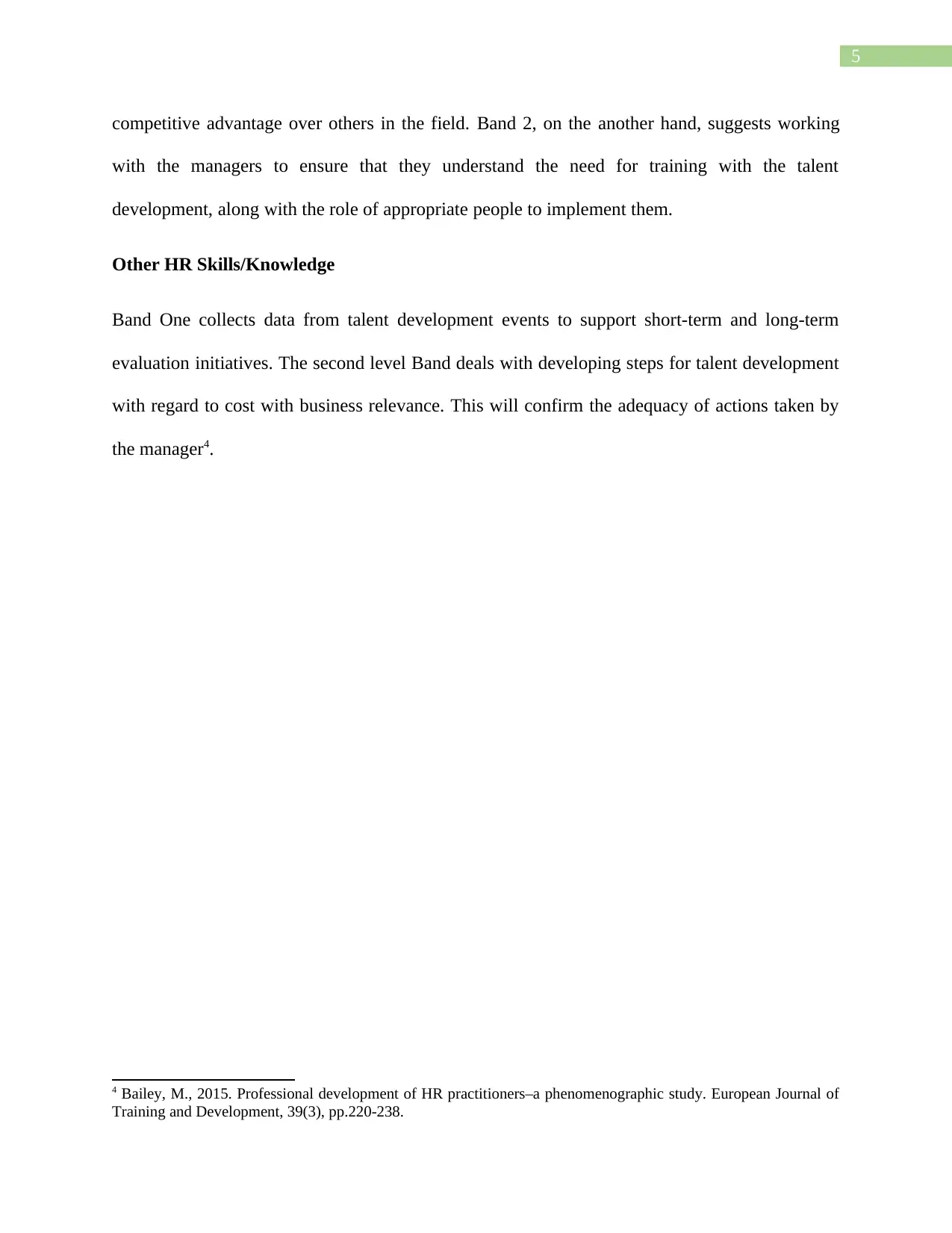
5
competitive advantage over others in the field. Band 2, on the another hand, suggests working
with the managers to ensure that they understand the need for training with the talent
development, along with the role of appropriate people to implement them.
Other HR Skills/Knowledge
Band One collects data from talent development events to support short-term and long-term
evaluation initiatives. The second level Band deals with developing steps for talent development
with regard to cost with business relevance. This will confirm the adequacy of actions taken by
the manager4.
4 Bailey, M., 2015. Professional development of HR practitioners–a phenomenographic study. European Journal of
Training and Development, 39(3), pp.220-238.
competitive advantage over others in the field. Band 2, on the another hand, suggests working
with the managers to ensure that they understand the need for training with the talent
development, along with the role of appropriate people to implement them.
Other HR Skills/Knowledge
Band One collects data from talent development events to support short-term and long-term
evaluation initiatives. The second level Band deals with developing steps for talent development
with regard to cost with business relevance. This will confirm the adequacy of actions taken by
the manager4.
4 Bailey, M., 2015. Professional development of HR practitioners–a phenomenographic study. European Journal of
Training and Development, 39(3), pp.220-238.
⊘ This is a preview!⊘
Do you want full access?
Subscribe today to unlock all pages.

Trusted by 1+ million students worldwide
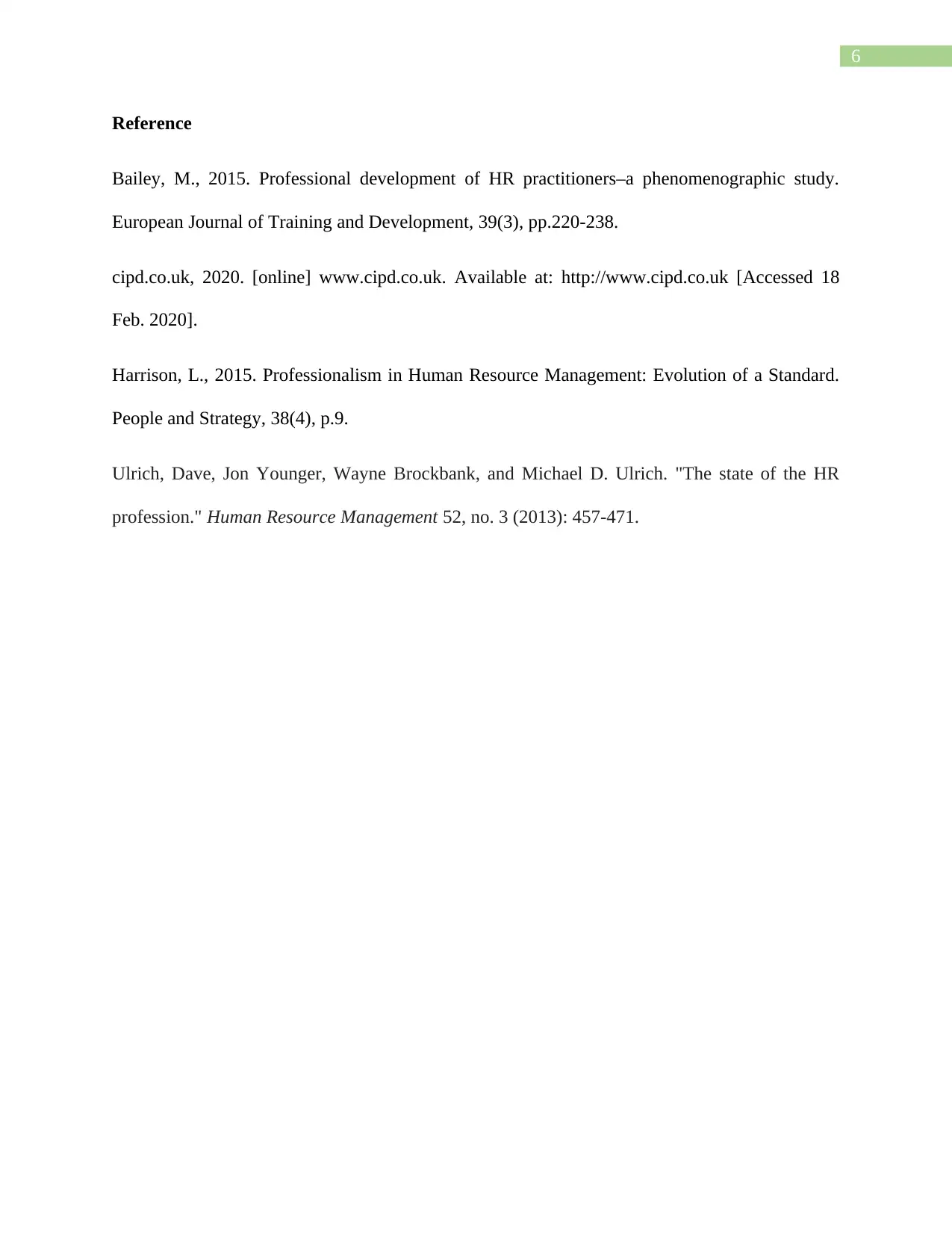
6
Reference
Bailey, M., 2015. Professional development of HR practitioners–a phenomenographic study.
European Journal of Training and Development, 39(3), pp.220-238.
cipd.co.uk, 2020. [online] www.cipd.co.uk. Available at: http://www.cipd.co.uk [Accessed 18
Feb. 2020].
Harrison, L., 2015. Professionalism in Human Resource Management: Evolution of a Standard.
People and Strategy, 38(4), p.9.
Ulrich, Dave, Jon Younger, Wayne Brockbank, and Michael D. Ulrich. "The state of the HR
profession." Human Resource Management 52, no. 3 (2013): 457-471.
Reference
Bailey, M., 2015. Professional development of HR practitioners–a phenomenographic study.
European Journal of Training and Development, 39(3), pp.220-238.
cipd.co.uk, 2020. [online] www.cipd.co.uk. Available at: http://www.cipd.co.uk [Accessed 18
Feb. 2020].
Harrison, L., 2015. Professionalism in Human Resource Management: Evolution of a Standard.
People and Strategy, 38(4), p.9.
Ulrich, Dave, Jon Younger, Wayne Brockbank, and Michael D. Ulrich. "The state of the HR
profession." Human Resource Management 52, no. 3 (2013): 457-471.
Paraphrase This Document
Need a fresh take? Get an instant paraphrase of this document with our AI Paraphraser
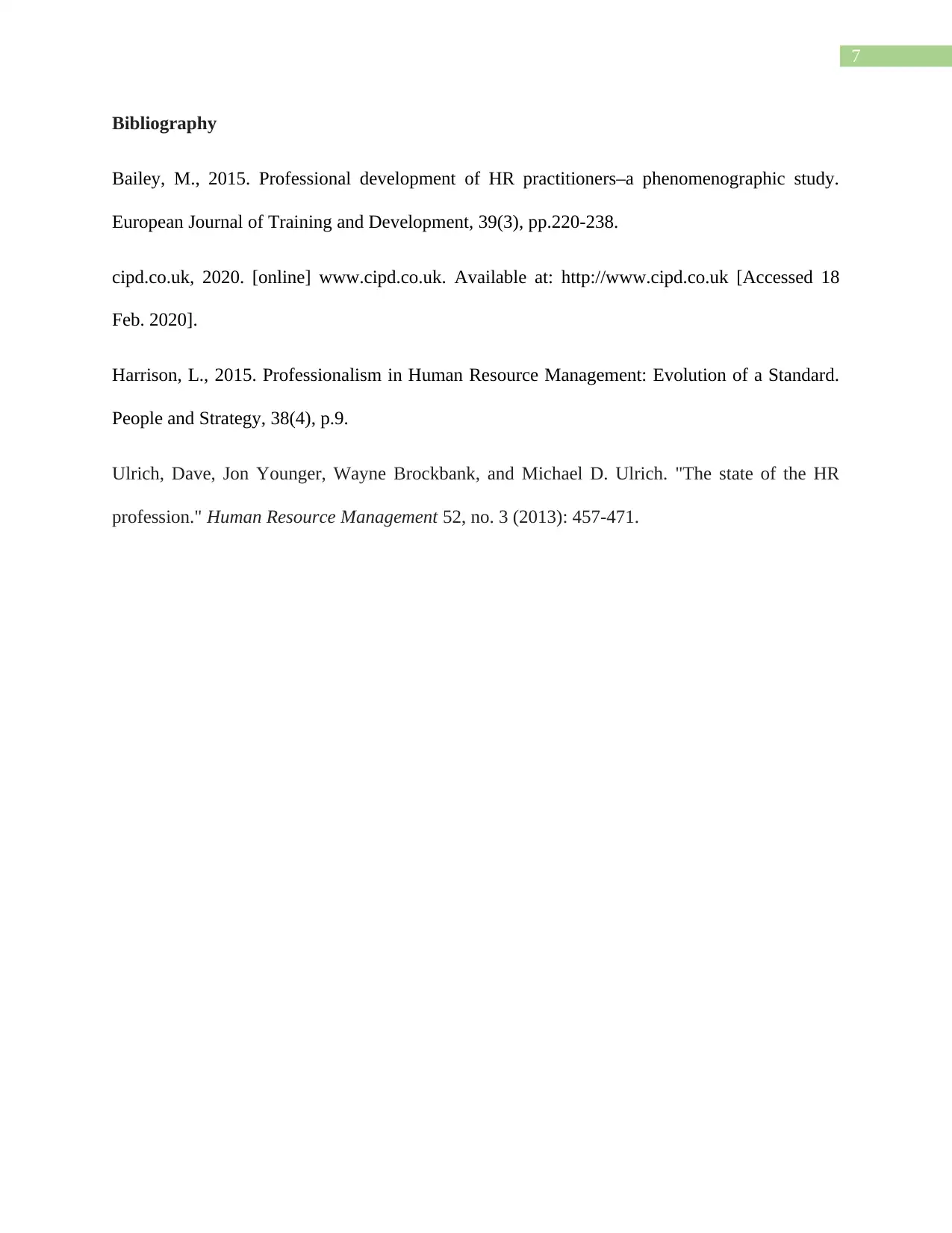
7
Bibliography
Bailey, M., 2015. Professional development of HR practitioners–a phenomenographic study.
European Journal of Training and Development, 39(3), pp.220-238.
cipd.co.uk, 2020. [online] www.cipd.co.uk. Available at: http://www.cipd.co.uk [Accessed 18
Feb. 2020].
Harrison, L., 2015. Professionalism in Human Resource Management: Evolution of a Standard.
People and Strategy, 38(4), p.9.
Ulrich, Dave, Jon Younger, Wayne Brockbank, and Michael D. Ulrich. "The state of the HR
profession." Human Resource Management 52, no. 3 (2013): 457-471.
Bibliography
Bailey, M., 2015. Professional development of HR practitioners–a phenomenographic study.
European Journal of Training and Development, 39(3), pp.220-238.
cipd.co.uk, 2020. [online] www.cipd.co.uk. Available at: http://www.cipd.co.uk [Accessed 18
Feb. 2020].
Harrison, L., 2015. Professionalism in Human Resource Management: Evolution of a Standard.
People and Strategy, 38(4), p.9.
Ulrich, Dave, Jon Younger, Wayne Brockbank, and Michael D. Ulrich. "The state of the HR
profession." Human Resource Management 52, no. 3 (2013): 457-471.
1 out of 8
Related Documents
Your All-in-One AI-Powered Toolkit for Academic Success.
+13062052269
info@desklib.com
Available 24*7 on WhatsApp / Email
![[object Object]](/_next/static/media/star-bottom.7253800d.svg)
Unlock your academic potential
Copyright © 2020–2025 A2Z Services. All Rights Reserved. Developed and managed by ZUCOL.




